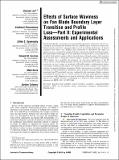| dc.contributor.author | Lee, Jinwook | |
| dc.contributor.author | Ramaswamy, Vaishnavi | |
| dc.contributor.author | Spakovszky, Zoltán S | |
| dc.contributor.author | Greitzer, Edward M | |
| dc.contributor.author | Drela, Mark | |
| dc.contributor.author | Talbotec, Jérôme | |
| dc.date.accessioned | 2022-09-09T13:36:12Z | |
| dc.date.available | 2022-09-09T13:36:12Z | |
| dc.date.issued | 2022 | |
| dc.identifier.uri | https://hdl.handle.net/1721.1/145334 | |
| dc.description.abstract | <jats:title>Abstract</jats:title>
<jats:p>Part II describes the experimental assessment and the application of the ideas in Part I concerning the mechanisms that determine the role of blade surface waviness on laminar-turbulent transition and their consequent effect on civil aircraft fan performance. A natural transition wind tunnel was designed and constructed to characterize the impact of surface waviness on transition, using both hotwire anemometry and infrared thermography. The experimental results support the new hypothesis presented in Part I, concerning the way in which blade surface waviness affects fan performance through motion of the transition onset location due to interaction between surface waviness and Tollmien–Schlichting (TS) boundary layer instability. In particular, the theoretical amplification of the TS waves, and the corresponding transition onset location movement due to surface waviness, was borne out over a range of variations in Reynolds number, nondimensional surface wavelength, nondimensional surface wave height, and location of surface wave initiation, relevant to composite fan blade parameters. Further, the increase of receptivity coefficient, and thus, the initial amplitude of disturbances due to geometric resonance between surface wavelength and TS wavelength was also confirmed by the experiments. Surface waviness was estimated, in some cases, to result in a nearly 1% decrease in fan efficiency compared to a nonwavy blade. Suggestions are given for mitigation of the effects of waviness, including the idea of blade curvature rescheduling as a method to delay transition and thus decrease loss.</jats:p> | en_US |
| dc.language.iso | en | |
| dc.publisher | ASME International | en_US |
| dc.relation.isversionof | 10.1115/1.4052236 | en_US |
| dc.rights | Article is made available in accordance with the publisher's policy and may be subject to US copyright law. Please refer to the publisher's site for terms of use. | en_US |
| dc.source | ASME | en_US |
| dc.title | Effects of Surface Waviness on Fan Blade Boundary Layer Transition and Profile Loss—Part II: Experimental Assessments and Applications | en_US |
| dc.type | Article | en_US |
| dc.identifier.citation | Lee, Jinwook, Ramaswamy, Vaishnavi, Spakovszky, Zoltán S, Greitzer, Edward M, Drela, Mark et al. 2022. "Effects of Surface Waviness on Fan Blade Boundary Layer Transition and Profile Loss—Part II: Experimental Assessments and Applications." Journal of Turbomachinery, 144 (2). | |
| dc.contributor.department | Massachusetts Institute of Technology. Gas Turbine Laboratory | |
| dc.contributor.department | Massachusetts Institute of Technology. Department of Aeronautics and Astronautics | |
| dc.relation.journal | Journal of Turbomachinery | en_US |
| dc.eprint.version | Final published version | en_US |
| dc.type.uri | http://purl.org/eprint/type/JournalArticle | en_US |
| eprint.status | http://purl.org/eprint/status/PeerReviewed | en_US |
| dc.date.updated | 2022-09-09T13:30:31Z | |
| dspace.orderedauthors | Lee, J; Ramaswamy, V; Spakovszky, ZS; Greitzer, EM; Drela, M; Talbotec, J | en_US |
| dspace.date.submission | 2022-09-09T13:30:33Z | |
| mit.journal.volume | 144 | en_US |
| mit.journal.issue | 2 | en_US |
| mit.license | PUBLISHER_POLICY | |
| mit.metadata.status | Authority Work and Publication Information Needed | en_US |
